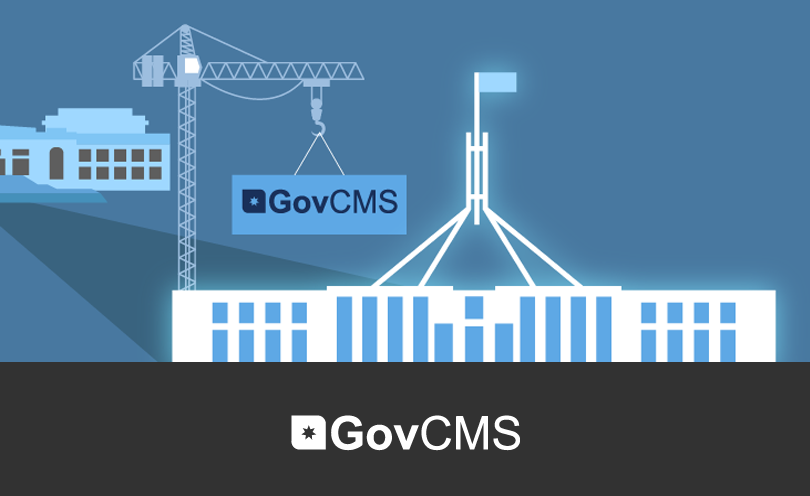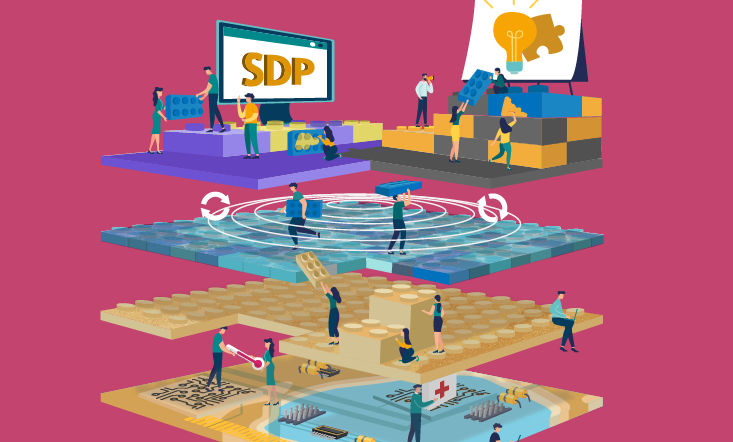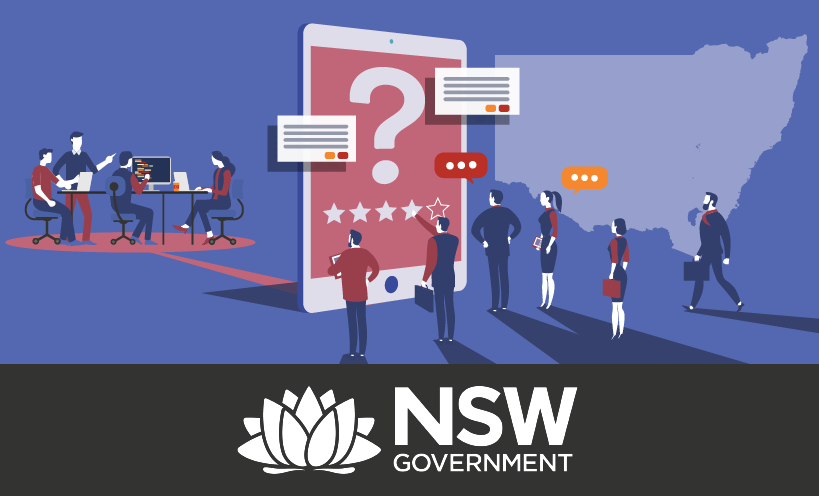Digital channels workshop
In February and March 2022, the legendary Pia Andrews delivered a series of internal workshops for Salsa. One of the workshops focused on digital channels. While Pia covered a lot during this session, an area that really interested us was the three different service delivery models for delivering government services. These service models run side-by-side with more information-based digital experiences, such as nsw.gov.au or canada.ca.
Information and transactions in digital services
Before we moved into the details of each service model, Pia clarified the difference between information and transactions in digital services. While many people think of digital services as being information OR transactions, she pointed out that information is actually in both.
She focused on the purpose. The purpose of all-of-government, information-based websites is to communicate with you about services, programs or government itself. Whereas the purpose of an integrated government channel is to deliver the services you get from government. Defining the purpose of a service helps differentiate and focus the delivery and operating model for it.
The service model is about ‘How can I help you with whatever you need?’
“It’s a culture of service.”
The three service delivery models
The three service delivery models are:
Fully consolidated/ integrated — a single point of contact for all government services and transactions
Partially integrated — a single point of contact for some government services and transactions
Distributed — a decentralised model with no single point of contact
Pia took us through the features of each model, using different jurisdictions as examples. Below is part of a summary table taken from Pia’s Service Delivery and Public Trust in New Zealand Aotearoa: a Discussion .
| Fully integrated | Partially integrated | Distributed | |
|---|---|---|---|
| How services are delivered | Single point of contact and resolution for citizens | Single point of contact and resolution across more than one portfolio, but it’s not whole-of-government | No single point of contact or resolution |
| Example | Service NSW | Service Canada | NZ Government |
| Description | An omni-channel virtual service delivery layer that sits in front of Westminster government structure for a cohesive and integrated citizen experience. | Current state: integrated phone and walk-in centre services for ESDC + extras. By end 2022: omni-channel integrated services for ESDC. Future state: AoG omni-channel. | Departmentally based service delivery with a single information website. |
| Scope of service | All-of-government Mandated single point of omni-channel service delivery for all NSW Government departments, except Justice systems and some exemptions. Service.nsw.gov.au is distinct from nsw.gov.au. | All of portfolio plus extras, expanding to all-of-government Single point of service delivery for Canada with in-person & phone channels, including AoG identity proofing and some Provincial gov services. Currently no single online Service Canada presence (distinct from Canada.ca). | No AoG service delivery An AoG website govt.nz but no AoG or cross portfolio service delivery. |
Fully integrated service model
A fully integrated model uses consolidated channels to deliver services to its citizens. Pia’s example of this model is Service . Service NSW was created in 2013 and provides more than 1200 transactions. Structurally, it’s part of the Department of Customer .
“This is about getting you to the services you need, the transactions. But it’s integrated. You don’t go to this department or that department. You don’t even know which departments serve up these services or own the programs. You don’t need to know anything about the structure of government. You only need to know Service NSW, which is so much more efficient.”
“The mandate of Service NSW is to own the customer interface. So no department runs a UI for their own services.”
She gave an example of registering a birth. The Registry is responsible for the program, the backend, managing birth records, etc. but the user interface is Service NSW. The front-facing experience is owned and controlled by Service NSW, while the BE content and data is owned and managed by individual government departments. This provides a consolidated, end-to-end experience for NSW citizens…a single point of contact through an omnichannel presence.
The fully integrated (consolidated) service model is the ideal model. It gives citizens a one-stop-shop where they can access all government services. However, this model requires a strategic and cultural shift. Agencies (and ministers) must move away from owning their websites (at least the front end) and also away from owning specific audiences. There is also a significant amount of work involved in implementing a fully integrated service model.
Pia’s Service Delivery and Public Trust in New Zealand Aotearoa: a Discussion steps out a phased approach to a consolidated model, specifically looking at how NZ could transform.
Partially integrated service model
In this model, some government services have been consolidated and can be accessed via a single point of contact. However, it’s not fully consolidated as a whole-of-government solution. Pia’s example of this model is Service (although it’s currently transforming to the consolidated model).
Service Canada started as mostly a physical service offering, with Service Canada walk-in centres. They looked after social services for Employment and Social Development Canada (ESDC) but also look after passports and other services from departments across the Canadian Government. Anything in-person could be through a Service Canada centre.
“But online, there was very little consolidation, apart from identity passthrough. When I got to Service Canada, they had recognised that and wanted to establish a proper omnichannel approach including a new digital channel.”
Pia worked in Canada for nearly two years, moving them from a partially integrated service model towards a fully integrated service model. During the workshop, Pia detailed the work she did with Service Canada, including the blueprint for service delivery. For more information, please read our blog What it takes to run a fully integrated government service delivery model.
The partially integrated service model is definitely a good place to start. By bringing high-volume services onto one channel, it’s helping citizens interact with government. The key, however, is to ensure it’s an entity with ownership over the end to end CX (like Service NSW) with one agency in charge of bringing siloed agencies on board. Otherwise, you still end up with a fragmented tapestry of services where each department owns the CX, so the CX is fragmented.
Distributed service model
This is a siloed, decentralised approach. Each government department/agency looks after its own website and any related services for citizens. Pia gave NZ as an example of this model, with the exception of (which provides info and services based on the life journey of becoming pregnant). She also mentioned the service integration for the Ministry of Social Development through as an example of one department integrating their own services, but little cross departmental service integration.
The Australian Federal Government is another example Pia gave of a distributed model. Each department runs its own content and is responsible for its own user interface.
There are no real pros with the distributed service model, except that staying with the status quo won’t involve any one-off setup costs. This model is based on an old-style approach to government, where each department is responsible for its own services and citizens have to deal with multiple departments to access services.
Salsa’s contribution to consolidation
There are many jurisdictions around the world that have little to no consolidation across government. While Pia’s discussion paper and her workshop focused on government services, it’s important to recognise other areas of consolidation for governments.
Consolidation of information-based government sites
Consolidation of information-based sites improves citizens’ user experiences. Both vic.gov.au and nsw.gov.au are good examples of this type of consolidation, as they bring many disparate websites onto the one website.
Salsa started working with Customer Service NSW in 2020 (see our 2020 case study for details on our Drupal work with ). We’re currently providing content services for three site migrations onto , as NSW continues to consolidate government information. We’re also delivering content strategy and Drupal development services for the overall site taxonomy of . It’s exciting to be part of the consolidation effort in NSW!
Consolidation with whole-of-government platforms
Content consolidation also requires a shared content management system. Integration using a shared tech platform is obviously much more achievable than starting from scratch. Whole-of-government platforms like GovCMS (federal) and Single Digital Presence (Victoria) help to start the ball rolling with consolidation. Find out more about our role in and our role in .
Recent work at Geoscience Australia is also a good example of consolidation, although its focus is on consolidating information and data rather than services. Salsa is working with Geoscience and GovCMS to pioneer new government digital platform approaches. Geoscience Australia’s Digital Earth (DEA) site is the pilot of a broader objective to generate efficiencies and savings for Geoscience Australia. The focus is on modern architectures to address the duplication of features, content, user experience, platform hosting, website maintenance, integration and other operational costs.
Open data and consolidation
Open data also plays an important role in consolidation. Central platforms where people can access datasets provide a fully integrated (consolidated) approach to data sharing. While Geoscience Australia is an example for earth data, the state and federal data portals provide one-stop access for jurisdictional data.
Salsa Digital’s take
The sessions with Pia have provided invaluable insights into government digital strategy, in this case the three different service delivery models and how to build a fully integrated/consolidated service model. Salsa is committed to helping governments with consolidation across all areas — from platforms to services. We’re keen to see more jurisdictions explore and transition to a fully integrated service delivery model like Service NSW. And we’re excited to be part of the journey.




